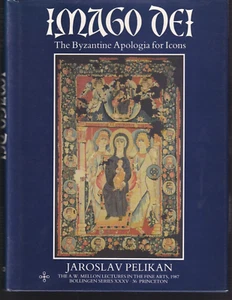Imagen 1 de 2


Galería
Imagen 1 de 2


¿Quieres vender uno?
IMAGO DEI: THE BYZANTINE APOLOGIA FOR ICONS By Jaroslav Pelikan (1990 HC)
USD28,00
Aproximadamente24,16 EUR
Estado:
En muy buen estado
Libro que se ha leído y que no tiene un aspecto nuevo, pero que está en un estado excelente. No hay desperfectos visibles en la tapa y se incluye sobrecubierta, si procede, para las tapas duras. Todas las páginas están en perfecto estado, sin arrugas ni roturas y no falta ninguna. El texto no está subrayado ni resaltado de forma alguna, y no hay anotaciones en los márgenes. Puede presentar marcas de identificación mínimas en la contraportada o las guardas. Muy poco usado. Consulta el anuncio del vendedor para obtener más información y la descripción de cualquier posible imperfección.
Oops! Looks like we're having trouble connecting to our server.
Refresh your browser window to try again.
Envío:
Gratis USPS Media MailTM.
Ubicado en: Wolcott, Connecticut, Estados Unidos
Entrega:
Entrega prevista entre el vie. 1 ago. y el mié. 6 ago. a 94104
Devoluciones:
No se aceptan devoluciones.
Pagos:
Compra con confianza
El vendedor asume toda la responsabilidad de este anuncio.
N.º de artículo de eBay:145925143091
Características del artículo
- Estado
- Features
- Dust Jacket
- ISBN
- 9780691099705
Acerca de este producto
Product Identifiers
Publisher
Princeton University Press
ISBN-10
0691099707
ISBN-13
9780691099705
eBay Product ID (ePID)
955006
Product Key Features
Number of Pages
208 Pages
Language
English
Publication Name
Imago Dei : the Byzantine Apologia for Icons
Subject
Subjects & Themes / Religious, Byzantine Empire, History / General
Publication Year
1990
Type
Textbook
Subject Area
Art, History
Series
The A. W. Mellon Lectures in the Fine Arts Ser.
Format
Hardcover
Dimensions
Item Height
1 in
Item Weight
36.9 Oz
Item Length
10.3 in
Item Width
7.8 in
Additional Product Features
Intended Audience
College Audience
LCCN
90-036835
Dewey Edition
22
Reviews
"Pelikan clearly delineates the path the theological defense of icons took during the iconoclastic controversies of the eighth and ninth centuries ... Commendably Pelikan addresses the role played by the other senses in the defense of icons. The fact that touch, taste, audition and smell were acceptable made it easier to argue for the place of the visual." -- Theological Studies, Pelikan clearly delineates the path the theological defense of icons took during the iconoclastic controversies of the eighth and ninth centuries ... Commendably Pelikan addresses the role played by the other senses in the defense of icons. The fact that touch, taste, audition and smell were acceptable made it easier to argue for the place of the visual.
Series Volume Number
36
Illustrated
Yes
Dewey Decimal
246/.5309021
Synopsis
In 726 the Byzantine emperor, Leo III, issued an edict that all religious images in the empire were to be destroyed, a directive that was later endorsed by a synod of the Church in 753 under his son, Constantine V. If the policy of Iconoclasm had succeeded, the entire history of Christian art--and of the Christian church, at least in the East--would have been altered. Iconoclasm was defeated--by Byzantine politics, by popular revolts, by monastic piety, and, most fundamentally of all, by theology, just as it had been theology that the opponents of images had used to justify their actions. Analyzing an intriguing chapter in the history of ideas, the renowned scholar Jaroslav Pelikan shows how a faith that began by attacking the worship of images ended first in permitting and then in commanding it. Pelikan charts the theological defense of icons during the Iconoclastic controversies of the eighth and ninth centuries, whose high point came in A.D. 787, when the Second Council of Nicaea restored the cult of images in the church. He demonstrates how the dogmas of the Trinity and the Incarnation eventually provided the basic rationale for images: because the invisible God had become human and therefore personally visible in Jesus Christ, it became permissible to make images of that Image. And because not only the human nature of Christ, but that of his Mother had been transformed by the Incarnation, she, too, could be "iconized," together with all the other saints and angels. The iconographic "text" of the book is provided by one of the very few surviving icons from the period before Iconoclasm, the Egyptian tapestry Icon of the Virgin now in the Cleveland Museum of Art. Other icons serve to illustrate the theological argument, just as the theological argument serves to explain the icons.
LC Classification Number
BR238.P44 1990
Descripción del artículo del vendedor
Acerca de este vendedor
KKZBOOKS
100% de votos positivos•1,9 mil artículos vendidos
Registrado como vendedor particularPor tanto, no se aplican los derechos de los consumidores derivados de las leyes de protección de los consumidores de la UE. La Garantía al cliente de eBay sigue aplicando a la mayoría de compras. Más informaciónMás información
Categorías populares de esta tienda
Votos de vendedor (806)
- 3***h (314)- Votos emitidos por el comprador.Mes pasadoCompra verificadaFast Delivery, Item(s) as Described, Good Communication, Excellent Seller.
- f***e (407)- Votos emitidos por el comprador.Últimos 6 mesesCompra verificadaPackage arrived on time, gigo dolls was packaged really good, items was as described, I’m getting closer to getting my collection completed. Thanks you so much! 😊
- n***e (1273)- Votos emitidos por el comprador.Últimos 6 mesesCompra verificadaBeautifully and carefully packaged and very well protected from typical careless delivery by USPS . This book is exactly as described and in very good condition. Thank you so much.

